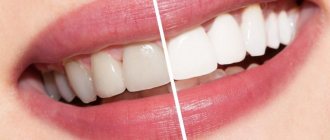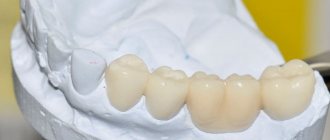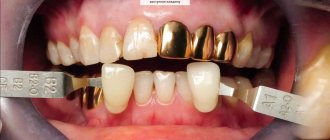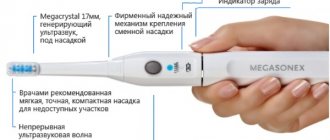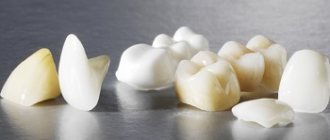Options Types of crowns Stages of prosthetics Stages of prosthetics How to choose?
Features of care For prosthetics of chewing teeth, various orthopedic structures and materials are used, the choice of which depends on the degree of damage to the unit. The chewing group includes premolars (4, 5), molars (6, 7, 8), located on the sides of the dentition. These units (except for the “eights”) are millstones, the function of which is to thoroughly grind food for subsequent absorption by the body. That is why crowns for chewing teeth are made of durable materials that can withstand high loads.
A dental crown is a single prosthesis that imitates the supragingival part of a tooth. Since premolars and molars are constantly exposed to high loads, and caring for them is difficult due to their anatomy and location, they are more susceptible to destruction as a result of injuries, caries, and other dental diseases. If the supragingival part is destroyed by more than 50%
, an artificial crown will help restore the functionality of the unit. Such prostheses are created from different materials, which determines cost, aesthetics, and durability.
Dental crowns in our clinic
At OWN PEOPLE dentistry, crowns are selected individually for each patient. Our doctors will take into account all the client’s wishes, including the appearance of the prosthesis. One of the main principles of the clinic is the availability of care. Therefore, when selecting a crown, dentists also focus on the patient’s budget and the cost acceptable to him.
All stages of manufacturing and installation of crowns are controlled by the attending physician. This ensures high quality and long-lasting wear of the prostheses. And after installation, the dentist conducts a detailed consultation on wearing and caring for the crown.
Free consultation!
Our clinic provides free consultations, during which the dentist will determine whether the patient needs a crown and outline a rough treatment plan. You can discuss with him the materials and methods of making prostheses in order to choose the most convenient one. The doctor will also tell you what procedures will have to be completed before installing a crown and what costs the patient should expect.
Main types of dentures
This is the name given to custom-made orthopedic structures that replace lost teeth. They are installed with the aim of restoring the aesthetic appearance and chewing function, as well as eliminating diction disorders.
Based on the type of fixation in the oral cavity, there are three main types of prostheses:
- non-removable – designed to replace several missing dental units (bridges) or restore a damaged tooth (crowns, inlays, veneers);
- conditionally removable - can only be removed by a specialist for maintenance or repair, attached to pins implanted in the jaw;
- removable - products made of metal, plastic, which are fixed with different types of fastenings to healthy teeth or with the help of special glue in case of complete edentia. Constructions of this type are divided into complete and incomplete in terms of volume of replacement of dental units.
Complete dentures
Designed to restore teeth when they are completely missing, they are made of hypoallergenic acrylic plastics. They consist of a base adjacent to the gum and crowns attached to it. A well-made artificial upper jaw is held in place well by negative pressure between the gum and the denture bed. The lower denture, as a rule, is less well fixed, so dentists recommend additionally using special adhesives.
Complete denture
Partial
They are installed in the presence of supporting dental units, correcting included or end defects. Metal, plastic, acrylic in various combinations are used in production. Modern orthopedic dentistry offers several options for partial structures that are fixed with locks, clasps, and other types of fasteners. The chewing load is evenly distributed both on the jaw tissue and on the prosthesis.
Indications for installation
Artificial crowns are installed in place of the destroyed part of the tooth. The procedure is carried out according to indications:
- more than 70% of the natural tooth crown is destroyed;
- inability to use other correction methods;
- there are large cracks and chips on the enamel;
- a fracture of the natural crown was established;
- high abrasion of enamel in the patient.
Temporary crowns are installed while the tooth is being treated. They allow you to maintain an aesthetic appearance and a beautiful smile.
Prices
| Primary appointment (examination, consultation) with an orthopedic dentist | 1,150 rub. |
| Repeated appointment (examination, consultation) with an orthopedic dentist | 100 rub. |
| Tooth restoration with a temporary crown using the direct method | 2,500 rub. |
| Tooth restoration with a permanent crown (CEREC method) | 32,000 rub. |
| Tooth restoration with a permanent metal-free crown “Imax” with individual aesthetics (application method) | 35,000 rub. |
| Tooth restoration with a permanent metal-free ceramic milled crown | 28,000 rub. |
| Tooth restoration with a permanent metal-ceramic crown | 15,000 rub. |
| Tooth restoration with a permanent all-metal crown | 6,000 rub. |
| Restoring a tooth with a crown using a solid core inlay | 7,000 rub. |
| Restoring a tooth with a crown using a solid core inlay. Stump inlay made of zirconium dioxide | 15,000 rub. |
| Tooth restoration with a crown. Combined tooth. Metal-ceramic crown on an implant | 20,000 rub. |
| Trephination of tooth, artificial crown | 500 rub. |
Contraindications
Not all patients can have crowns. Contraindications to the procedure:
- the last stage of periodontitis - the prosthesis may fall out due to weakened jaw tissue;
- enamel fragility - due to the risk of tooth decay;
- Bruxism - increased tone of the jaw muscles during stress or sleep;
- small height of the teeth and their incorrect position - the crown will not hold;
- pathological bite with incisal overlap - artificial crowns will wear out and destroy healthy teeth.
For some crown materials there are age restrictions for use. Therefore, only a doctor can choose the right prosthesis during a personal consultation.
Our advantages
At the OUR PEOPLE clinic, they value the health of their patients, so doctors install crowns only when indicated. If this method of prosthetics is not suitable, the dentist will select another correction method. An individual approach and attention to each patient is the key to high quality medical care at the SVOI PEOPLE clinic. Thanks to this, our clients wear dental crowns for many years.
Differences between a crown and a filling
A crown should not be confused with a filling. They both serve the same purpose - to fill a missing tooth. However, a filling is a mass that is applied to the tooth itself and adapts to its shape. A crown is, as a rule, a kind of cap that is placed on the remainder of the tooth or on an abutment. This design has its own shape that imitates a human molar. A crown is installed when a tooth is 60-70% or even more lost. A filling – when a smaller part of a tooth is missing.
What are they: materials
Crowns can be made from a wide range of materials. Some of them contain a metal base, others are completely synthetic. The choice of material depends on the purpose of the crown, wearing time, wishes for appearance and financial capabilities of the patient.
Metal ceramics
Crown with a metal frame and ceramic coating. The material is reliable and aesthetically pleasing. But there are several contraindications to metal-ceramic dental crowns:
- gum recession - the denture becomes visible;
- age under 18 years - thin enamel in children, which is why there is a risk of injury to the pulp when grinding the tooth.
For the adult population, metal-ceramic crowns are considered an excellent option for correcting dentition.
Metal composite
The product has a frame made of an alloy of cobalt and chromium, and a photopolymer composite is used for cladding. The crown is formed in a soft state and then hardens under the light of an ultraviolet lamp.
The result is a thin and durable coating. But the photopolymer composite is colored by bright pigments in food and drinks, so the patient will have to limit himself in consuming such products.
Golden
The material, tested by time and many patients, is gold. It is a precious metal, so it is hypoallergenic. Such products are perfect for people with high sensitivity to foreign materials.
Gold is a soft metal, which is why crowns quickly wear out under the pressure of antagonists. But they do not spoil the enamel of healthy teeth.
Zirconium dioxide
The most modern material for making crowns is zirconium dioxide.
| pros | Minuses |
| High strength; | High price. |
| Aesthetics; | |
| Hypoallergenic; | |
| Long service life. |
In terms of the ratio of advantages and disadvantages, this material is the most optimal of all possible. But the high price is not for everyone.
Metal-free
Modern techniques for making crowns make it possible to avoid metals in the composition of the product. This is especially important for those who are allergic to them, and you don’t want to lose aesthetics by installing a gold model.
Ceramic
Ceramic crowns are the most similar to natural teeth. They have a sufficient degree of transparency, and can also be matched in color to match natural enamel.
But such crowns are fragile and fragile. Therefore, they are used for the front teeth, and for the back teeth you will have to choose a different material.
Porcelain
Porcelain crowns are not as popular, but they have many advantages.
| pros | Minuses |
| Anatomical shape; | Fragility; |
| High accuracy; | High price; |
| Comfortable wear; | Loose fit; |
| Strong fixation; | High risk of destruction of adjacent teeth. |
| Minimal risk of loosening; | |
| High aesthetics; | |
| Durability; | |
| No staining; | |
| Resistance to temperature changes; | |
| Hypoallergenic. |
In terms of the ratio of pros and cons, porcelain products win in many respects. But people with thin enamel are not recommended to have them installed due to the risk of damaging healthy teeth.
Combined
Models made from combined materials are suitable for long-term wear. They can be used for teeth with any location: they are aesthetically pleasing for the front ones and can withstand the load of the back ones.
Such products are not without drawbacks. They quickly wear out and wear out, and can become deformed. But this is a fairly budget option for prosthetics.
Plastic
The products are only suitable as a temporary tooth replacement. They are light and comfortable, their production takes little time and does not require a large budget. While the permanent structure is being prepared, you can use plastic crowns, but you won’t be able to wear them for a long time - they simply won’t withstand the load.
Advantages of artificial crowns:
Advantages of artificial crowns
- Increasing the physical and mechanical characteristics of the crown of a natural tooth due to the circular coverage of the dental stump with a solid structure;
- The ability to reproduce or correct the appearance of the crown in the desired direction;
- The ability to perform the function of a supporting element of a fixed or removable prosthesis.
If all conditions are met, the possible disadvantages of this design (for example, bleeding, temporary whitening or a feeling of pressure in the area of the adjacent gum) are mild or completely absent. However, it should be understood that while performing a restorative and, to a certain extent, preventive function, orthopedic treatment does not affect the main cause of caries - the acid produced by plaque microorganisms. This means that daily personal oral hygiene measures must be carried out in full.
Each type of crown is characterized by its own manufacturing technology: metal ones are cast or stamped, plastic and composite ones are polymerized, ceramic ones are sintered, pressed, milled. Those previously used (stamped with plastic lining, partial, metal-plastic) are now rarely used. Despite this circumstance, at the present stage of development there is a sufficient variety of options to find the optimal solution in each case.
The choice of material and technology depends on the objectives of the individual clinical situation.
Types and methods of making a crown
Products differ not only in service life and materials of manufacture, but also in appearance. The doctor selects the appropriate option during a personal consultation, since an in-person examination of the patient is required.
Bridges
The design is relevant for patients who are missing more than one tooth. In this case, a complex prosthesis is made, the parts of which are connected by a bridge. It is attached to healthy teeth, thus holding crowns. This method is not used for single prosthetics.
Implant supported crowns
If the patient has already installed implants, they can be used as a support for the crown. This will avoid unnecessary stress on healthy teeth and prevent their wear. But if the patient does not have implants, this technique cannot be used.
Crown for one tooth
Most often, patients come with a request to install a crown on one tooth. This is relevant for single destruction from caries or injury. The method of installing a crown is selected based on the condition of the gums, periodontium and bone plates. In some cases, additional operations are required before installing the structure.
Fixation with a pin
A method that is used less frequently than others is placing the crown on a pin. This is a traumatic operation that can cause serious complications. Therefore, they try to abandon this method if alternative methods are available to the patient. If not, the operation is carried out in several stages with constant medical supervision at each of them.
Cast crowns
The most reliable and durable designs are cast crowns. They are made from a single piece of material. The product is highly durable and lasts longer. But this manufacturing technique is not suitable for all materials.
Stamped
To stamp crowns, a dental anvil is used, the processes of which follow the shape of the teeth. To get a stamp, use rubber rings. To make metal crowns, hammers of various sizes and shapes are used. The final form of the prosthesis takes place after processing with special forceps.
Such dentures are cheaper to produce than cast ones. But they are easier to deform and wear out faster. The service life of such prostheses is much shorter.
Comparative characteristics of artificial crowns
| Variety | Positive traits | Negative qualities |
| Metal (stamped and cast); | Stamped – gentle preparation (only the most protruding part of the crown around the circumference is ground); | Cast – hardness and bioinertness of noble alloys (does not interact with the body). |
| Combined (metal-ceramics) |
|
|
| Plastic and composite (currently used only as temporary) |
|
|
| Metal-free (ceramic and zirconium dioxide-based) |
| The relative fragility of pressed ceramics (IPS Emax technology, used only in the anterior part of the dental arches) |
Date of publication: September 20, 2020 Last update: September 22, 2022 © 2020 Professorial Dentistry “22 Century”. All rights reserved.
How a tooth crown is made
Before you start making a crown, you need to decide on its shape and size. To do this, do:
- visual inspection;
- overview and targeted x-ray;
- 3D – computer visualization of a model of the jaw and tooth.
Making a crown for a tooth depends on its type, the material used and the production method. An impression of the patient's jaw is taken as a sample. They are sent to the laboratory to create a plaster model. After drying, the master cuts out the desired element and makes a prototype of it from wax.
Then the resulting model is fixed on the base and filled with a specialized mixture. In this state it remains in the oven for 4-5 hours. Then the mold is taken out and, while it is still hot, filled with alloy. Until the moment of hardening, the future artificial tooth remains in such a position so that its deformation does not occur.
GENERAL PROVISIONS:
1.1.
This Policy regarding the processing of personal data (hereinafter referred to as the Policy) is drawn up in accordance with clause 2 of Art. 18.1 of Federal Law No. 152-FZ of July 27, 2006 “On Personal Data” as amended by Federal Law No. 16 of February 22, 2017, and is the fundamental internal regulatory document of the Limited Liability Company “SELLADENT” (hereinafter referred to as the Organization), defining key areas its activities in the field of processing and protection of personal data (hereinafter referred to as PD), the operator of which is the Organization. 1.2. The policy was developed in order to implement the requirements of the law in the field of processing and protection of personal data and is aimed at ensuring the protection of the rights and freedoms of an individual and citizen when processing his personal data in the Organization, including the protection of rights to privacy, personal, family and medical secrets.
1.3. The provisions of the Policy apply to relations for the processing and protection of PD received by the Organization both before and after approval of the Policy, except for cases where, for reasons of legal, organizational and other nature, the provisions of the Policy cannot be extended to relations for the processing and protection of PD received before its approval.
1.4. PD processing in the Organization is carried out in connection with the Organization’s performance of the functions provided for by its constituent documents and determined by:
- Federal Law of November 21, 2011 No. 323-FZ “On the fundamentals of protecting the health of citizens in the Russian Federation”;
- Federal Law No. 152-FZ of July 27, 2006 “On Personal Data”; Federal Law No. 16 dated February 22, 2017
- Decree of the Government of the Russian Federation of September 15, 2008 No. 687 “On approval of the Regulations on the specifics of processing personal data carried out without the use of automation tools”;
In addition, the processing of personal data in the Organization is carried out in the course of labor and other directly related relations in which the Organization acts as an employer (Chapter 14 of the Labor Code of the Russian Federation), in connection with the implementation by the Organization of its rights and obligations as a legal entity.
1.5. The organization has the right to make changes to this Policy. When changes are made, the date of the last update of the edition is indicated in the title of the Policy. The new version of the Policy comes into force from the moment it is posted on the website, unless otherwise provided by the new version of the Policy.
1.6. The current edition is stored at the location of the Organization at the address: Moscow, st. Novoryazanskaya 38, building 3, electronic version of the Policy - on the website at: https://www.al-bis.ru/about/confidential/
Installation process
The procedure for installing a crown is multi-stage. Often the patient has to visit the doctor more than two or three times. It all depends on the initial condition of the teeth and their sensitivity to the therapy, if necessary.
At the initial stage, the doctor conducts a diagnosis, determines the plan and scope of work, and calculates the approximate cost. Often at this time it is still unclear how long the treatment will take, because each body reacts to therapy in its own way.
Laboratory stage
Most of the steps involved in installing a crown take place in the laboratory. At this stage:
- obtain dismountable models of jaws from plaster;
- make a stamped crown;
- grind and polish the product to an ideal shape.
The laboratory accompanies the patient at all stages of installation. The crown can be returned for revision even at the very last moment, since it is important that the patient feels comfortable wearing it.
Grinding the tooth before installation
The most difficult stage, which most patients fear, is teeth grinding. It is necessary to ensure that the crown fits perfectly to the gums. If this is not observed, a pathological pocket will form. Food will get stuck in it, which will cause inflammation and can lead to tooth extraction.
Grinding is carried out under anesthesia, so the patient will not feel anything. Only the top layer of enamel is ground. The tooth itself is not damaged; only 1-2 mm are removed. The depth of work depends on the selected crown material: a smaller volume is sufficient for ceramics, while metal-ceramics require more space.
The purpose of grinding is to equalize the width of the tooth at the neck and at the equator. This is necessary for strong fixation of the crown. It is covered by the gums, which prevents loosening. After processing, there should be no convex parts left - they are sanded off with a special apparatus. At the same time, the chewing teeth must maintain their relief in order to fully perform their functions.
In some cases, during turning, depulpation is additionally performed. This is done according to strict indications, about which the patient is warned in advance.
In case of extensive tooth decay, a stump inlay can be installed. It protects healthy soft tissues from the pressure of the crown on them. Previously, in this case, installation was carried out using pins. Now this technique is not so relevant, since the operation is associated with certain risks. And if it is possible to avoid them using a stump tab, it is better to do so.
Installing a crown on a tooth
A permanent crown is not installed immediately. First, a fitting is carried out, during which the patient evaluates several parameters:
- shape;
- wearing comfort;
- color.
If one of the parameters does not fit, it is better to redo the crown. After all, you need to remember that it will take a long time to wear it, and the cost of manufacturing and installation is usually expensive.
And the appropriate crown is securely fixed with cement. The strength of the installation is checked by a doctor to ensure that the prosthesis does not accidentally fall out.
Monitoring the situation after installation
Once the crown is in place, you need to check whether the installation was completed correctly. To do this, a panoramic or targeted photograph of the oral cavity is performed, depending on the number of installed dentures. Only after this the doctor allows the patient to go home.
If a patient has questions about discomfort or inconvenience when wearing a crown, he can call the doctor at the OWN PEOPLE clinic and ask all his questions. Our dentists care about their clients and are always responsible for the results of the procedure.
Possible problems and complications
Installation of a metal-ceramic crown is a mini-operation in the oral cavity, with local anesthesia at the request of the patient, possible (but unlikely) problems. The more positive the clinic’s reputation, the lower the risk of complications, since this is based on the doctor’s mistake.
The most common occurrence is the development of caries under the crown. Causes:
- drying of the tooth if the nerve is removed;
- violation of tightness.
Prevention is considered to be proper dental care. Visiting the dentist once every six months will also prevent complications.
Although metal ceramics are considered biocompatible with the tissues of the human body, another complication that can appear both immediately after installation and several years after installation is toxic or allergic stomatitis. Without ulcers, but with swelling of the tongue, difficulty breathing, drooling, burning of the tongue. With toxic stomatitis, there will be a deterioration in health (pain, heaviness in the liver, kidneys), itchy skin, and urticaria. Please note: if the frame is made of gold or silver-palladium, cases of such stomatitis are rare.
Sometimes patients complain of chipping of the ceramic coating. Most likely reasons:
- incorrect frame modeling;
- improper processing of the area for ceramics (the surface is too smooth, poorly polished, without an oxide film, etc.);
- selection of materials without taking into account physical and chemical characteristics;
- violation of the technology of applying layers, firing and cooling;
- too many firings to change color or shape (ceramics shrink);
- uncorrected occlusal interlocking contacts;
- internal stresses in the metal part of the crown due to improper preparation of the supporting teeth and fitting of the frame.
If the ceramic part breaks off, you need to contact an orthodontist. If a piece is swallowed, it is advisable to immediately rinse the stomach.
Pros and cons of crowns
It is impossible to call the installation of crowns a uniquely positive procedure. It has a number of contraindications and disadvantages. But there are much more advantages from it, so it has not lost its relevance for decades.
Advantages
There are significantly more positive aspects of crown prosthetics than negative ones. The advantages of the procedure include:
- maintaining the health of the tooth when it is partially destroyed;
- restoration of chewing function of the jaws;
- protection against tooth decay with removed pulp;
- restoration of intelligible and clear speech;
- possibility of crown replacement;
- restoration of the aesthetic appearance of the smile.
A large number of advantages outweigh some of the disadvantages of the procedure. But they are still worth considering before deciding to install.
Flaws
Like any medical procedure, crown placement is not without its drawbacks. Its disadvantages:
- significant grinding of healthy tooth tissue;
- the procedure is not performed if the root is damaged;
- limited crown service life;
- the need for regular monitoring by a doctor.
Despite the number of shortcomings, dental crowns remain popular and in demand. This is an effective way to restore the integrity of your smile and jaw function without significant financial investment.
What awaits a patient undergoing a clinical crown lengthening procedure?
Read about the orthodontic, orthopedic and therapeutic method of lengthening the crowns of teeth in the relevant sections - on orthodontics (installation of braces), prosthetics with crowns and veneers, and restoration. In this article we will focus on surgical lengthening of the crown of one, and more often, several frontal teeth.
Basically, in this case, they resort to gingivoplasty - a surgical operation during which part of the gum is removed along the gingival contour, often this intervention also requires the removal of part of the bone.
This manipulation is performed by a dental surgeon in a surgical office, on an outpatient basis, under local anesthesia and, sometimes, sedation.
Such an operation is prescribed after a thorough diagnosis, in most cases - as a stage in complex treatment and the formation of an aesthetic smile.
- Before any surgical intervention, professional hygiene and sanitation of the oral cavity are carried out to reduce infection in the oral cavity and speed up healing.
- The patient is given anesthesia.
- After which, if resection (removal) of a part of the bone is required, the mucoperiosteal flap is peeled off and an osteotomy is performed. A new gingival contour is formed, which is located above the previous one.
- The wound is sutured and a gum bandage is applied.
- In the postoperative period, for a speedy recovery, the patient is prescribed antiseptic rinses and painkillers, and a course of antibiotics may be prescribed. It is necessary to limit physical and chewing activity.
- The stitches are removed after about 7-10 days.
- Immediately after the wound has healed, a temporary restoration or prosthetics is performed, and after a few months the temporary structures are replaced with permanent ones.
- Complete restoration of the new natural gum margin occurs in 1-3 years.
If it hurts under the dental crown
Installing a dental crown is a complex operation. Therefore, after it, pain may be observed for 2-3 days. This is a normal reaction of the body to intervention. Therefore, doctors recommend taking painkillers during this period.
If your tooth hurts for a week or more, you should consult a doctor for a second examination. It is possible that a pocket has formed between the gum and the crown where food has entered. This can cause inflammation. In this case, you need to start treatment as early as possible so as not to lose the tooth.
Advantages of metal-ceramic crowns
Metal-ceramic crowns, which are most often used in dentistry, have many advantages. The main ones include:
- reasonable cost;
- high quality;
- shape and color of natural teeth;
- durability.
Everyone knows that some people cannot install metal crowns. Firstly, they do not look very aesthetically pleasing. And secondly, some people simply experience allergic reactions. As for ceramic crowns, they are hypoallergenic and completely safe.
In the manufacture of such prostheses, only proven and high-quality materials are used. Such crowns are used if the tooth is severely damaged. It is also worth noting that such crowns, unlike metal ones, do not injure the gums and neighboring teeth. Also, such dentures are installed on chewing teeth, since they cope well with this function.
The service life of metal-ceramic implants is quite long. But again, it all depends on how correctly the crown was made, from what materials, and the like. Therefore, dentists strongly recommend visiting only proven and well-established dental centers with highly qualified specialists.
How to take impressions correctly?
If the mucous membrane was damaged when grinding the native crown, the procedure for taking impressions should be postponed until it is restored.
- In some patients, the injured gum can give recession - move away from the neck of the tooth and expose its root.
- Due to the presence of blood, the materials used to obtain impressions may not clearly depict the formed ledge.
As a result, the edge of the manufactured and installed crown will stick out above the gum, which will significantly reduce the aesthetics of prosthetic treatment of the front teeth.




